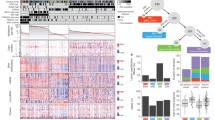Abstract.
The relative contribution of tumour histology or molecular changes, compared with invasion pattern or stage, to prognostic assessment of gastric cancer was investigated in a series of 185 advanced (T2 to T4, stage IB to IV) cancers that had undergone intentionally curative surgery at Varese General Hospital. Survival analysis of the histological types considered in commonly used classifications, such as Lauren, Kubo, the World Health Organization (WHO) and related classifications, allowed separation of a small high-grade (Hg, 12 cases) group of adenosquamous, anaplastic and small cell endocrine carcinomas from a large cohesive group (C, 86 glandular or solid cancers) and from another large (87 cases) group of tumours with dissociated cells [29 diffuse (D) and 58 mixed (M) tumours]. Univariate and multivariate analysis showed the independent prognostic value of this C/M+D/Hg classification approach, which proved superior to other classifications and to cell dissociation at the growing front or angio, lympho and neuroinvasion. Expression of sialyl Lewisc, the DUPAN-2 antigen, proved to be an independent predictor of worse survival among tumours beyond stage I, showing an exclusively or predominantly cohesive structure. Microsatellite instability (MSI) predicted favourable survival in purely cohesive tumours of intermediate (II) stage, especially of solid/medullary and lymphoid stroma/lymphoepithelioma-like structure, among which two distinct tumour subsets were characterised, one MSI-positive and the other Epstein-Barr virus positive. T2N0M0 (stage IB) tumours showed mostly favourable survival independently from histological type, invasive pattern, DUPAN-2 or MSI status. It is concluded that an appropriate histological evaluation, coupled with sialylated glycoproteins histochemistry and, for stage-II tumours, MSI tests may contribute significantly to prognostic assessment of tumours beyond stage I. However, the stage itself, with special reference to lymph-node metastases and invasion level beyond subserosa, remains the most important prognostic clue for gastric cancer.
Similar content being viewed by others
Author information
Authors and Affiliations
Additional information
Electronic Publication
Rights and permissions
About this article
Cite this article
Chiaravalli, A., Cornaggia, M., Furlan, D. et al. The role of histological investigation in prognostic evaluation of advanced gastric cancer. Virchows Arch 439, 158–169 (2001). https://doi.org/10.1007/s004280100441
Received:
Accepted:
Published:
Issue Date:
DOI: https://doi.org/10.1007/s004280100441




